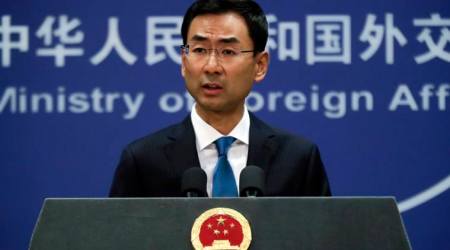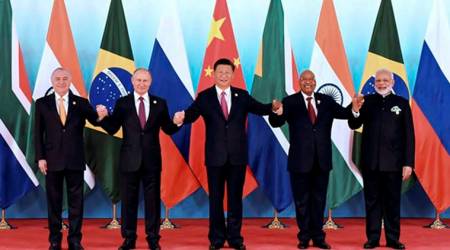 Xiamen: Chinese President Xi Jinping, left, and Indian Prime Minister Narendra Modi attend the group photo session at 2017 BRICS Summit in Xiamen, Fujian province in China, Monday, Sept. 4, 2017. AP/PTI(AP9_4_2017_000016B)
Xiamen: Chinese President Xi Jinping, left, and Indian Prime Minister Narendra Modi attend the group photo session at 2017 BRICS Summit in Xiamen, Fujian province in China, Monday, Sept. 4, 2017. AP/PTI(AP9_4_2017_000016B)
In getting the Chinese to agree to name two Pakistan-based terrorist groups — Lashkar-e-Taiba and Jaish-e-Mohammad — in the Xiamen declaration, Indian negotiators had worked with Beijing for the last three months, sources told The Indian Express. Interestingly, this ran on a track almost parallel to negotiations over the Doklam border standoff. The Indian side told Chinese interlocutors that as a “major power”, their country should play the role of a “big responsibility”, sources said. They said it took three months to convince China that naming the terrorist groups would make Beijing look like they are shouldering the responsibilities of a major power.
One of the key elements in this strategy, sources said, was the fact that the US under President Donald Trump was seen to be ceding space in global governance, and New Delhi gauged that the Chinese would be keen to capture that leadership space at the global stage. Diplomats spotted this opportunity when Chinese President Xi Jinping, early this year, went to Davos and became a proponent of globalisation, at a time when the new US administration under Trump was being seen as rooting for “protectionism”. So, the Xiamen declaration also makes a reference to the BRICS grouping being opposed to “protectionism” — a term absent in the Goa declaration.
After Trump announced exiting the Paris Agreement, the pot was stirred further. During conversations, Indian and Chinese officials decided to take a strong stand on climate change. Weeks later, during G-20 summit negotiations in Hamburg, Chinese and Indian officials, along with French and German, were at the forefront of the opposition to the US over the Paris pact.
Around that time, after PM Narendra Modi met Trump in Washington and terrorist groups were named, sources said the first talks about getting China to sign on the terrorism paragraph in the BRICS declaration started. “They were told that since they are the leading power in the world, they must take a moral and political position on terrorism. After weeks of talking to them, they were quite enthused at the prospect of looking good at the global stage,” a source said.
While the Indian side’s expectation of China removing its technical hold on listing Jaish-e-Mohammad chief Maulana Masood Azhar as a terrorist is quite “realistic”, a source said, “We are not looking at immediate gains from this formulation. But, over time, we may be able to move in the right direction.”
The Chinese, sources said, “are quite clear about taking such principled positions on one hand, and being realistic on the other.” They indicated China may not yet leave Pakistan’s side when it comes to “real action”. The inclusion of East Turkestan Islamic Movement was done at China’s request — as a quid pro quo. With inclusion of Taliban and ISIS, Russia played along and Brazil and South Africa did not block the consensus at BRICS.
Wang Dehua, director, Institute for South and Central Asia Studies in Shanghai, told The Indian Express, “The BRICS countries seem to have arrived on some consensus on terrorism and Monday’s declaration proves that. In recent times, China has been discussing the threat it faces from the East Turkestan Islamic Movement (ETIM) and India, in the past, has not been happy with China over Masood Azhar…“After the BRICS declaration, it seems the Indian side refused to budge on including JEM and LeT in the joint declaration. The Doklam issue was also closed last week. These are big issues between India and China and these chapters are now much closer to being solved. The border disputes will continue, but can eventually be solved through dialogue. India and China seem to be moving out of the shadows now and should cooperate more in the future.”

